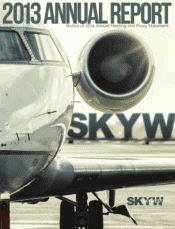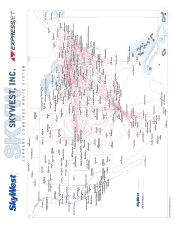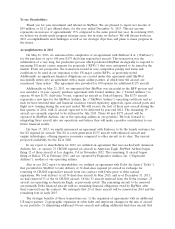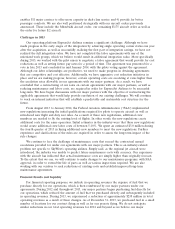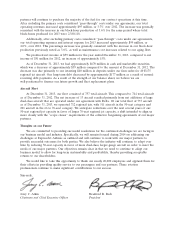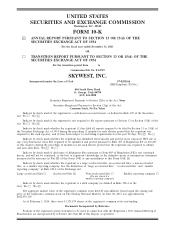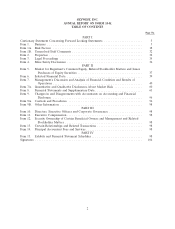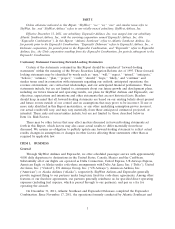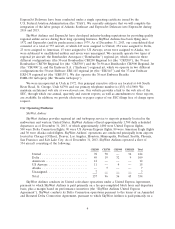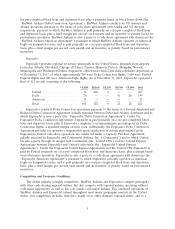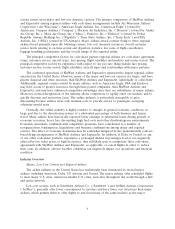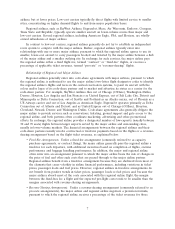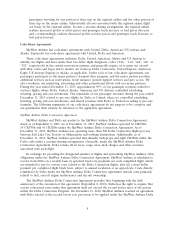SkyWest Airlines 2013 Annual Report Download - page 4
Download and view the complete annual report
Please find page 4 of the 2013 SkyWest Airlines annual report below. You can navigate through the pages in the report by either clicking on the pages listed below, or by using the keyword search tool below to find specific information within the annual report.enables US major carriers to offer more capacity in dual-class service and 4) provide for better
passenger comforts. We are also well positioned strategically with our aircraft orders previously
announced. These include the Mitsubishi aircraft order, our remaining E175 aircraft order as well as
the order for future E2 aircraft.
Challenges in 2013
Our operating platform ExpressJet Airlines remains a significant challenge. Although we have
made progress in the early stages of the integration by achieving single operating carrier status one year
after the acquisition, as well as successfully realizing the first part of integration savings, we have not
realized the full integration value. We have not completed the labor agreements with any of the
unionized work groups, which we believe would result in additional integration value. More specifically
during 2013, we worked with the pilot union to negotiate a labor agreement that would provide for cost
reductions as well as setting future pay rates for a period of time. The agreement was presented for a
vote in late 2013 and concluded in mid January 2014, with the pilots voting against the agreement.
Although our labor relationships are productive, we need to make progress in obtaining agreements
that are competitive and cost effective. Additionally, we have aggressive cost reduction initiatives in
place and we are making progress; however, certain operating costs are escalating at rates higher than
the escalation rates allowable in our agreements with our major partners. As a result, we have
concluded that a restructuring of our rates on certain agreements with our major partners, as well as
reducing maintenance and labor costs, are required in order for ExpressJet Airlines to be successful
long-term. We have begun discussions with our major partners with the objective of restructuring the
applicable agreements that would help provide resolution of our existing challenges. We will continue
to work on internal initiatives that will establish a predictable and sustainable cost structure for the
future.
From August 2013 to January 2014, the Federal Aviation Administration (‘‘FAA’’) implemented
new regulations increasing the initial qualifications required for pilots to operate aircraft as well as
introduced new flight and duty rest rules. As a result of these new regulations, additional crew
members are needed to fly the existing level of flights. In other words, the new regulations create
additional costs for the same operation. Initial estimates in the industry were that these new regulations
would create additional crew labor costs of between 5-10%. We spent an estimated $3.0 million during
the fourth quarter of 2013 in hiring additional crew members to meet the new regulations. Further
experience and clarifications of the rules are required in order to assess the long-term impact of the
rule changes.
We continue to face the challenge of maintenance costs that exceed the contractual annual
escalations provided for under our agreements with our major partners. This is an industry-related
problem not specific to SkyWest’s operating airlines. Simply said, as the regional jet aircraft were
introduced, the industry was unable to predict future maintenance costs with accuracy. Our experience
with the aircraft has indicated that actual maintenance costs are simply higher than originally forecast.
To the extent that we can, we will continue to make changes to our maintenance programs, with FAA
approval, in order to extend the life of parts as well as various inspections required. We are also
working with our vendors to seek reductions of existing costs and establish improved long-term
maintenance agreements.
Financial Results and Liquidity
For financial reporting purposes, we include in operating revenues the expense of fuel that we
purchase directly for our operations, which is then reimbursed by our major partners under our
agreements. During 2012 and throughout 2013, our major partners began purchasing fuel directly for
our operations, which reduced the amount of fuel that we purchased directly and subsequently included
in operating revenues. During 2013, we experienced a reduction of approximately $238 million in total
operating revenues as a result of these changes. As of December 31, 2013, we purchased fuel in a small
number of locations for our contract flying as well as for our prorate flying. We do not anticipate
similar reductions in our total operating revenues for 2014 and beyond as we believe our major

